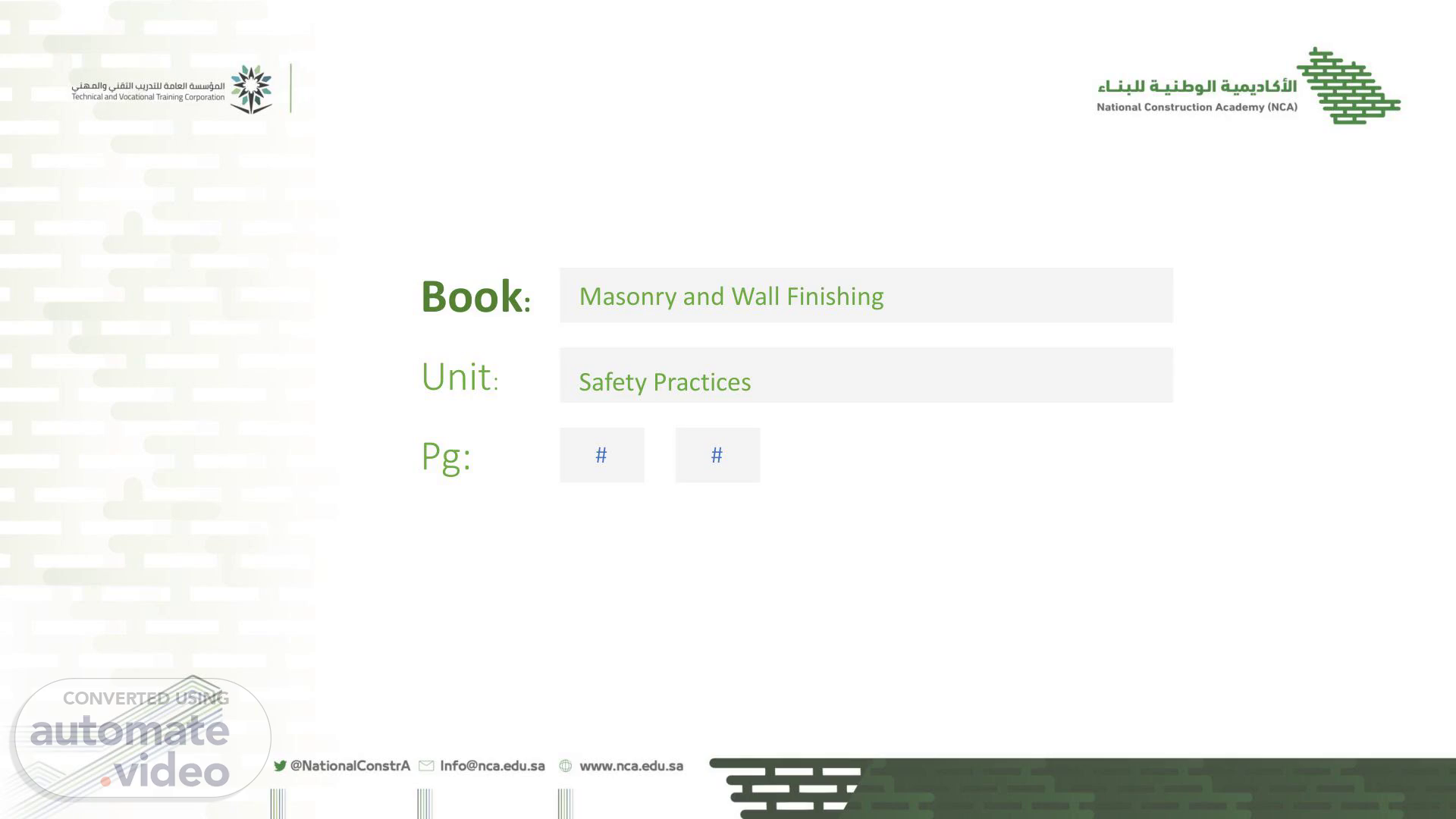Scene 1 (0s)
[Audio] Masonry and Wall Finishing Book: Safety Practices Unit: # # Pg:.
Scene 2 (7s)
[Audio] Introduction Safety practices are critical in masonry and wall finishing due to the high-risk nature of these construction tasks. Workers handle heavy materials, operate specialized equipment, and often work at heights, all of which can pose significant hazards if proper safety measures are not followed. This lecture provides a comprehensive overview of safety practices in masonry and wall finishing..
Scene 3 (34s)
[Audio] Objectives Safety Practices in Masonry and Wall Finish : Safety in workplace practice Personal protective Equipment (P-P-E--) Fall protection Hazardous materials https://www.youtube.com/watch?v=Ib4q5hsNlk.
Scene 4 (53s)
[Audio] Key Terms in Safety Practices 1. Personal Protective Equipment (P-P-E--): Gear worn by workers to protect themselves from specific hazards. 2. Scaffolding: Temporary structures used to support workers and materials during construction. 3. Fall Protection: Systems and practices to prevent falls. 4. Lockout/Tagout (L-O-T-O-): Procedures to ensure machines are properly shut down before maintenance or repair work. 5. Hazardous Materials: Substances that can pose risks to health, such as silica dust, asbestos, or lead-based paints..
Scene 5 (1m 37s)
[Audio] Importance of Safety in Masonry and Wall Finishing : 1. Protection of Workers: The primary goal of safety practices is to protect workers from injuries such as falls, cuts, or exposure to hazardous materials. 2. Compliance with Regulations: Following safety standards set by organizations like O-S-H-A ensures legal compliance and helps avoid fines or work stoppages. 3. Enhancement of Productivity: A safe work environment reduces the likelihood of accidents, leading to fewer disruptions and higher productivity. 4. Quality Assurance: When workers are safe, they can focus better on their tasks, resulting in higher-quality work and more durable structures..
Scene 6 (2m 26s)
[Audio] Personal Protective Equipment (P-P-E--) 1. Head Protection: Hard hats are essential to protect against head injuries from falling objects or debris. 2. Eye and Face Protection: Safety glasses or face shields protect against flying particles, dust, or chemical splashes. 3. Hand Protection: Gloves prevent cuts, abrasions, and chemical exposure. 4. Foot Protection: Steel-toed boots protect feet from heavy objects and sharp debris. 5. Respiratory Protection: Masks or respirators prevent inhalation of harmful dust or fumes..
Scene 7 (3m 17s)
[Audio] Scaffolding and Fall Protection 1. Scaffolding Setup: Ensure scaffolding is erected on a stable surface, properly secured, and inspected regularly. 2. Guardrails and Toeboards: Install guardrails on all open sides of the scaffolding to prevent falls. Toeboards help prevent tools or materials from falling off the scaffolding. 3. Fall Arrest Systems: Workers should wear harnesses connected to secure anchor points when working at heights..
Scene 8 (3m 46s)
[Audio] Safe Handling of Materials 1. Manual Handling: Use proper lifting techniques to avoid back injuries, such as lifting with the legs instead of the back and keeping the load close to the body. 2. Mechanical Handling: Use equipment like hoists, cranes, or forklifts for lifting heavy materials. Ensure that operators are trained and certified. 3. Material Storage: Store materials properly to prevent falls, spills, or other hazards. Heavy materials should be stored close to the ground..
Scene 9 (4m 21s)
[Audio] Hazardous Materials Management 1. Silica Dust Control: Implement dust suppression methods when cutting or grinding materials that contain silica. Wet cutting and vacuum systems can reduce airborne dust. 2. Asbestos Handling: If asbestos is present, workers must follow strict handling and disposal procedures to avoid exposure. 3. Lead-Based Paint: Use appropriate protective gear and work practices to minimize exposure, such as wet sanding and proper ventilation..
Scene 10 (4m 56s)
[Audio] Emergency Preparedness 1. First Aid Kits: Ensure that first aid kits are readily available and that workers are trained in basic first aid procedures. 2. Fire Safety: Know the locations of fire extinguishers and evacuation routes. Workers should be trained in the use of fire extinguishers. 3. Accident Reporting: Establish a protocol for reporting accidents or near misses immediately to supervisors..
Scene 11 (5m 25s)
[Audio] Practical Examples of Safety Practices 1. Safe Use of Scaffolding: A crew is working on the exterior of a building using scaffolding. Before work begins, the scaffolding is inspected to ensure it is properly erected on a stable surface, and guardrails are in place. 2. Silica Dust Control During Wall Finishing: Workers are grinding concrete for a wall finish. They use wet cutting techniques and wear respirators. 3. Proper Use of P-P-E During Masonry Work: A worker is cutting bricks for a masonry project. They wear safety glasses, gloves, and steel-toed boots..
Scene 12 (6m 5s)
[Audio] Discussion Questions Q1 : What are the most critical safety practices to follow when working on scaffolding in masonry and wall finishing? Q2 : How can workers be protected from the dangers of silica dust when cutting or grinding masonry materials? Q3 : Why is it important to regularly inspect scaffolding and other equipment on a construction site?.
Scene 13 (6m 31s)
[Audio] Summary The document highlights essential safety practices in masonry and wall finishing, focusing on the use of personal protective equipment (P-P-E--) like hard hats and respirators, proper scaffolding and fall protection, safe material handling, and managing hazardous materials such as silica dust. It also emphasizes emergency preparedness, including first aid and fire safety protocols. Practical examples include safe scaffolding use and silica dust control..
